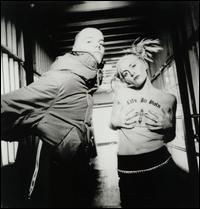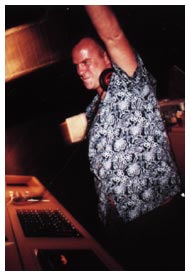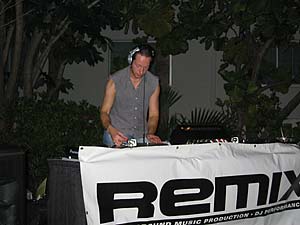I was involved in industrial culture for a long time. The music was really big for me right the way through my teens, since I got into Cabaret Voltaire when I was 13, and Psychic TV a year later. Almost a quarter of a century later, not much industrial music still sounds good, because vast amounts of it wasn’t any good anyway, but the best stuff has visceral energy, emotional impact, and the kind of transcendence most music simply doesn’t achieve. There’s been a frission of interest in, or at least references to, the industrial scene, for a couple of years now, accompanied by the much anticipated and hyped re-formation of Throbbing Gristle. It seems like a good time for me to re-appraise and wrap up this period of my life and the music that went with it, and in the process share some the best of it with people who either weren’t there first time, or passed it by. As the mix’ title suggests, I hope that what comes across is the sense of hope that emerges from amongs the harshness; to me, it’s no surprise that many in the industrial scene were later to become involved in dance music. Perhaps they simply discovered ecstasy before most people – you wouldn’t blame them…
The emphasis here is more on the ambient side of industrial than the banging noise side of industrial. As ever, before I do a mix or a piece of music, I live with it inside my head for some time before committing needle to Mac, and it was the more atmospheric tracks that “came through”. Despite being largely ambient, it’s still highly dynamic. Atonal and beatless for most of its duration, there is still a sense of lushness to this mix, and the snatches of melody and recognisable beats have enormous impact when they do appear. The structure of the mix mirrors fairly closely that which we would follow when doing work in this period, and the mix could be used as a meditational tool. But then what couldn’t?
The First Taste of Hope is Fear is here.
(30 minutes 32 seconds long; 42Mb; 192kbps MP3.)
1. Einsturzende Neubauten: Das Schaben. 7” included with the original pressing of the “Halber Mensch” LP. 1985.
“In the beginning there was noise.” That’s not quite the first principle of industrial but it’s the first impression people tend to get. Das Schaben means “the scraping”, and it is literally that – a load of metal scraping. And it’s beautiful. For me it represents clearing the circle; clearing your mind so you can focus.
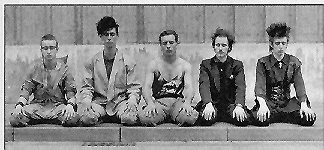
2. Throbbing Gristle. Heathen Earth. From the “Heathen Earth” LP. 1980.
Heathen Earth is probably my favourite TG album. Whether because or despite the lack of “songs” – and certainly it has no “hits” on it, no live versions of Discipline or Hamburger Lady for example – it’s glorious to listen to. It reminds me of Miles Davis. The performance is improvised, but it’s a focused piece of music. Here, this track creates the sensual space for what is to follow.
I’ve recorded it in slightly dubbed up form, reinforcing industrial’s obvious parallels with the Jamaican classics.


3. Coil. How to Destroy Angels. Laylah 12”. 1984.
A concept 12”: if that doesn’t define industrial I don’t know what does. The concept here being – according to the essay accompanying the record – the accumulation of male sexual energy, achieved through the gentle pummelling of gongs. This music is affecting and emotional in ways I can scarcely describe, yet there is nothing to it, just gamelan simplicity. It calls out elements.
The record is a great artefact, since the B-side is entirely blank, creating an ideal surface for scrying: pure, glossy, deep black.
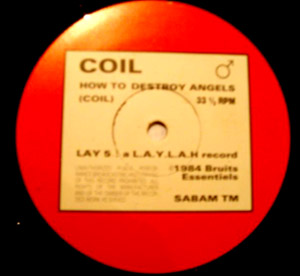
4. Einsturzende Neubauten: Halber Mensch. From the “Halber Mensch” LP. 1985.
From the accumulation of male sexual energy to the half-life of masculinity. Half-life as in both the atomic decay of life, the realisation of mortality (“The first and only thing we know is that we all die” – GPO, roughly) and the realisation that one is only half alive. To me, it encapsulated he horror of looking in the mirror and not recognising who is there. Here, it is the charge: the human vocalisation of one’s self, a determined assertion of presence.
When I was 16 I went to see Neubauten at Heaven. They started with this piece and it was, predictably, awesome. They followed with Yu Gung and a brace of other classics before the PA exploded. I spent three hours on the night bus back home to Essex.

5. Non. Blood and Flame. From the “Blood and Flame” LP. 1986.
I’m not sure which particular track this is and I’m certainly not going to find out, because all the track titles are terrible on this LP, but if you like waves of pulsating white noise, this track is killer. It’s fairly tasteful though, as waves of pulsating white noise go. Here, it’s the silence after the charge, where all senses are engaged.
There’s a story Phil Hine often tells about Chaos Magick and the perils of paradigm shifting. One of the aims of chaos is to become informed about, and at least partly agnostic about, one’s own belief systems. One way of achieving this is to practice paradigm shifting , where one adopts belief systems that are different from one’s own in order to understand their relativism. Anyway, this associate of Phil’s decides to take up the paradigm of fundamentalist Christianity – and gets so carried away that he joins a church and is born again.
Oh, the risks of Occultism.
Now, for those of you who don’t know, there was a time when Non’s Boyd Rice was a bright young star of industrial, one of its formative characters, and capable of great work. He was also a Premier League piss artist, wind-up merchant, and prankster. Even more so than Martin Dust. And he liked to play the dressing-up-in-militaria-and-growing-a-beard games that are all part of the fun of industrialism, and very good he looked too. Then, at some point in the 80s, he seemed to cross over the line between irony and sincerity, and took to proclaiming his fondness for Hitler, how American culture is a victim of political correctness, etc. Yeugh. Eden’s take on all this is that he “has taken up so many ludicrous positions over the last 10 years that it’s impossible to think that he isn’t playing the game purely for laughs” . Eden / Kali from back in the day nailed the whole Cold Hard and Black Nazi / Satan schlock-slop here – read it, and see what real industrial philosophy was about. Personally I just think Rice is a wannabe-macho prick; and no doubt he thinks the joke’s on me.
Great tune though.
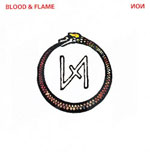
6. Laibach. Die Liebe. 12”. 1985.
To me this song is the pop music counterpart to Heathen Earth. In particular, it’s a pop music recapitulation of the question on the sleeve of Heath Earth: can the world really be as sad as it seems? It is this yearning which is the emotional well-spring of much industrial music, and which is often over-looked by the non-cognoscenti. After the assertion of life: reclaiming feeling.
Laibach history.
Laibach’s Guiding Principles, 1982.

7. Coil. The Sewage Workers Birthday Party. 1984.
I was a teenage Coil fan. I used to exchange letters with John Balance and everything. It was a really big part of my life. All the usual teenage fandom clichés apply – I resonated with the songs emotionally, I identified with their ideology and belief systems, and their music provided me with a place of refuge. The track here is pretty much a song, based on a coprophagic gay S&M story. It’s very beautiful: squidgy, rich, and romantic.
The main Coil site.
8. Laibach. Vade Retro. From the “Nova Akropola” LP. 1985.
There’s an old Wiccan saying – it must date back to the seventies at least – that “Where there’s fear there’s power”. It’s very true and worth reflecting on, and I don’t mean that in the sense of knee-jerk teen age miserabilism or aggression. A lot of good industrial dealt with fear – not as a means of diminishing the listener, but of empowering them, allowing them to unpick their fear. This track is startling at least. The ritual enacted is unnerving, yet these are Yugoslavian materialists, not occultists – at least, I never heard anything about Laibach being involved in magick. Yet it still poses the question: what, and who, are you actually afraid of?

9. Psychic TV. In the Nursery. From the “Dreams Less Sweet” LP. 1983.
If Vade Retro plays at being fearsome, In The Nursery is the real thing. It’s certainly unsettling, but that’s not because of over-wrought spookier-than-thou occultnikism. No, this song is about responsibility. It’s about taking responsibility for your own feelings and desires – all of them – and neither erasing them nor being enslaved by them. What does “no guilt and no retribution” mean? Does it really mean horror? Is that really what happens when you get what you want?

10. Psychic TV. Eleusis. From the “Dreams Less Sweet” LP. 1983.
Burroughs said that art was what was left after the magick. Eleusis is Andrew Poppy’s art.
11. Test Department. And We Shall Return No More. From the “A Good Night Out” LP. 1987.
Industrial musicians always had a penchant for folk music, which was of course deeply unfashionable at the time, and this was Test Dept’s take. I saw them at Bishops Bridge Maintenance Depot, a vast train service space in the backwaters of Paddington. It was a vast performance, totally filling the space, with troupes of ballet dancers, huge metal constructions, enormous video projections, and armies of military drummers and bagpipe players. The brobdignagian scale of state power, and even more so of the potential resistance to that power, was artfully displayed. Here Test Dept deploy their full vigour, but filtered through purely organic tones and forms. This song earths the industrial current.
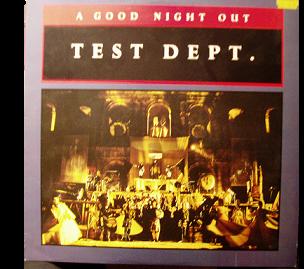
================================================================
Like this:
Like Loading...



